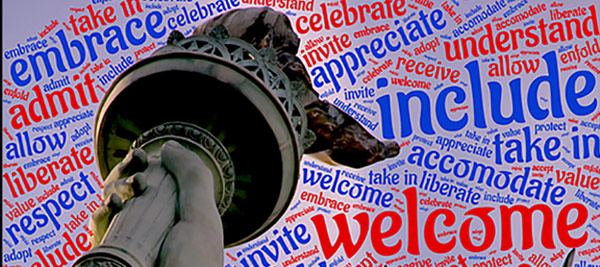Talking Criminal Justice Reform Issues
As communicators, we’re always looking for new ways to engage with audiences and consider what kind of messages break through and stick, and how to avoid empty rhetoric that leaves no impact.
Behavioral economics is an approach that encourages us to predict what people are likely to do in decision-making contexts instead of assuming that people make choices based only on logic and rational thinking. By understanding what influences real choices, we can design choice settings that guide people to choose in a certain way. This memo examines several behavioral economics principles and the implications they have on messaging around criminal justice reform issues. It is based on a full report that was written and researched for The Opportunity Agenda by Sabrina Hassan. For a full version of the report upon which this memo is based, please visit www.opportunityagenda.org.
Principles
- Social Norms – We tend to follow the herd. We gravitate toward choices that other people make, especially people whom we perceive to be similar to us in some way. For example, if we hear that most citizens in our community vote, or that our neighbors are doing a good job of conserving energy, we are more likely to make these choices as well.
- Loss Aversion – We favor avoiding losses over acquiring gains. The pain of loss exceeds the pleasure of gain. So simple framing about what we lose if we make one choice can be stronger than emphasizing what we gain with the same choice.
- Limited Attention – When our attention is depleted, we don’t make good decisions. When given limited information or a focal point, we’re better able to concentrate on and consider our decisions about information. Messaging with less and more targeted information is more effective than using too much and getting too complicated.
- Identity – We embrace ideas and actions that affirm our self-concept and reject those that threaten it. If we identify as Democrats or Catholics, for instance, we are more likely to make choices that we think Democrats or Catholics would choose, even if those choices may conflict with other beliefs or understandings.
1. Social Norms
People demonstrate a tendency to conform to perceived behavior of others in their groups. In other words, a person is likely to do what she thinks “everyone else” is doing. Research has shown people gravitate toward perceived social norms around:
- Voting.
- Whether to litter or engage in criminal acts.
- Adjusting their levels of energy use.
- Whether to react to an emergency.
- How quickly to finish easy tasks.
Implications for Messaging
The practical application of social norms is straightforward: publicize evidence that the vast majority of a group to which a given audience belongs (women, seniors, communities of color) does something the audience should be doing.
Social Norms: “People like you do .”
For example, there are several ways in which public opinion supports the movement to reform drug policy. Advertising these popular opinions can increase their popularity via our tendency to follow the herd. It is important to tailor the norms advertised as specifically as possible to the composition of the target audience (e.g. Democrats, New Yorkers, young professionals), because people align their behaviors with groups with whom they identify. Some potentially useful norms:
- 84% of American voters support non-prison alternatives such as drug treatment, community service, or probation for drug and other “victimless” offenses.
- Majorities of many American groups believe too many people are in prison—64% of Democrats, 59% of African Americans, and 58% of Latinos.
- Majorities of American groups would prefer that more money and effort go toward better education and job training, attacking the social and economic problems that underlie crime, instead of toward deterring crime with more prisons, police and judges—78% of Democrats, 77% of those aged 18-29, and 72% of college post graduates.
The above are merely a few examples. Majority opinions of peer groups are contagious, so a current sound and reliable statistic that reflects a majority opinion worth spreading can be used as a tool.
2. Loss Aversion
People are loss averse, meaning they prefer avoiding losses to making gains. The psychological pain of losing X exceeds the pleasure of gaining Y. Take the following example for illustration:
Problem 1: Which do you choose?
Get $900 for sure OR 90% chance to get $1,000
Problem 2: Which do you choose?
Lose $900 for sure OR 90% chance to lose $1,000
Most people are risk averse in Problem 1, choosing the certain $900 over the very likely $1000 to avoid the 10% risk of getting nothing. But in Problem 2, the opposite is true. Although the amounts are identical, most people choose to gamble on the 90% probability that they will lose an additional $100; they risk losing the larger amount rather than admitting a loss of ten percent less.
The results above demonstrate loss aversion, our built-in distaste for losses. Loss aversion also explains why people buy insurance they don’t need and refuse to settle a lawsuit they will likely lose. We detest losses so much that we pay extra for a narrow possibility of escaping them.
Implications for Messaging
Loss aversion is a useful tool in designing choices because whether something is perceived as a loss depends on how it is framed. Just as a glass of water can be deemed half empty or half full, a policy can be described in terms of its costs or its benefits.
For example, a number of facts about laws pertaining to people who have been convicted of sex-related conduct can be framed to highlight the loss to society that dangerous laws cause.
- The over-inclusion of people on the registry of sex-related conduct makes it difficult for law enforcement to determine which people warrant more careful monitoring.
- The large volume of people who pose no threat, but who are required to register, demands hours of administrative police work and sometimes even requires paying for overtime to keep up with demand.
- Residency restrictions push people away from the supervision, treatment, stability and supportive networks they may need to build and maintain successful, law-abiding lives.
- Residency restriction laws cause police to lose track of people who move around or drop out of sight to avoid compliance with the law.
3. Limited Attention
Each person’s pool of mental energy is shared by cognitive, emotional, and physical efforts. Consider how hard it is to concentrate on work after receiving shocking news, or to perform complex mental math while walking. (If you’re like most people, you’ll stand still to finish computing.) When a person exerts self-control by thinking hard, exercising vigorously, or suppressing emotion, she will eventually experience a diminished capacity to regulate her thoughts, feelings and actions. Poor decisions ensue.
Implications for Messaging
In designing choice settings, we must make the effort to simplify complex or lengthy processes that lead to a desired result. Even better, we can “pad the path of least resistance” with default rules that transparently funnel people to one path unless they opt out. When we eliminate attention-sucking decision points with a default rule, such as automatic employee enrollment in a retirement plan, people are more likely to subscribe to a choice rather than avoid choosing at all.
These principles apply in messaging. By simplifying messages and eliminating decision points—on whether to turn a page, download a document, or do mental math—the messenger can increase the chance that an audience will remain attentive enough to absorb her message.
In a field as well documented as the failed “War on Drugs,” it can be tempting to share heaps of facts and figures with any attentive audience. But more information shared doesn’t necessarily translate into more information received. The way to capitalize on the attention we get is to maximize the impact, not the volume, of our messages.
Most Americans believe crime is increasing despite the reality that violent crime has been at historic lows for the past few years. We thus can’t assume that Americans perceive the gross increase in imprisonment as bad or illogical. We have to spell out the problem. Fortunately, an audience unfamiliar with or resistant to the glaring flaws in American drug policy needs to accept only a few simple facts to grasp the issue:
- Right now, the United States imprisons an astronomical number of people compared to both our own historical rates and to those of other countries.
- The increase in imprisonment for drug offenses results from harsher sentencing policy, not from an increase in convictions for drug offenses.
- Treatment delivered in the community costs approximately $20,000 less than imprisonment per person per year.
Focusing the message on the key points makes these points easier to learn and remember.
4. Identity
We are very attached to our identities. I believe that I am X kind of person, and X kind of person believes and does Y. The attachment is so strong that it may account for my inaccurate beliefs and irrational behavior.
Implications for Messaging
- Present accurate information in a graphic or visual, rather than textual, format. Presenting corrective information graphically is shown to be more effective than conveying the same information through words alone.
- Leverage the power of self-affirmation—support perceptions of self-worth. Having a person engage in self-affirmation, as with recalling a time she felt good about herself, increases her willingness to admit a position that conflicts with her identity. Self-affirmation can reduce misperceptions even without corrective information.
- Label an individual as a certain kind of person, such as “voter” or “consumer,” to encourage her to act accordingly. In a 2011 study, participants received surveys that referred to voting using either a self-relevant noun (e.g., “How important is it to you to be a voter in the upcoming election?”) or a verb (e.g., “How important is it to you to vote in the upcoming election?”). Those who completed the surveys identifying them as prospective “voters” (noun condition) expressed significantly greater interest in registering to vote and significantly increased voter turnout than those in the verb condition.
In the case of racial profiling, focusing on the values and identity of someone who believes in equality and who is against racism can help elevate the case against police behavior that violates those values. Equality is one of the core values on which our nation was founded. In theory at least, our tolerance of diversity sets the United States apart from other countries. So even though we all have biases beyond our control, most Americans at least aspire to not be perceived or labeled as “racists.” Yet racial bias, whether individual and overt or structural and subconscious, causes racial profiling. There thus exists a messaging opportunity to gently leverage audience aversion to racial bias and racism to promote a stance against racial profiling.
Help people to identify with their support for equality by explicitly naming it as part of their identity.
- Are you a supporter of racial equality?
- This petition seeks signatures from supporters of racial equality.
- The shooting of another unarmed Black man is expected to draw criticism and protests from supporters of racial equality.
- Supporters of racial equality will likely back the proposed legislation.
In sum, when delivering messages designed to garner opposition to racial profiling, offer a self-relevant noun against such profiling to which your audience can subscribe.




